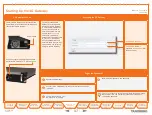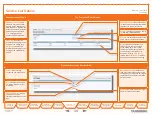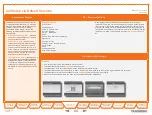
D13841.08
10.2007
11
TANDBERG
3G GATEWAY
USER GUIDE
Never install telephone wiring during a lightning storm.
•
Never install telephone jacks in wet locations unless the
•
jack is specifically designed for wet locations.
Never touch uninstalled telephone wires or terminals unless
•
the telephone line has been disconnected at the network
interface.
Use caution when installing or modifying telephone lines.
•
Avoid using a telephone (other than a cordless type) during
•
an electrical storm. There may be a remote risk of electrical
shock from lightning.
Do not use the telephone to report a gas leak in the vicinity
•
of the leak.
The socket outlet shall be installed near to the equipment
•
and shall be easily accessible.
Never install cables without first switching the power OFF.
•
This product complies with directives: LVD 73/23/EC, EMC
•
89/366/EEC, R&TTE 99/5/EEC.
This product complies with the standards GR-63-CORE and
•
GR-1089-CORE and is NEBS approved by UL. For NEBS
compliance, there should be a clearance of 9.1 cm between
the product and any other product mounted in the rack.
To avoid damage to the unit during transportation, the 3G
Gateway is delivered in a special shipping box, which should
contain the following components:
3G Gateway Server
•
Network cables
•
ISDN cables (5m) (Qty 4) – only if the 3G/Audio GW 4xBRI
•
option is chosen
ISDN cables (5m) (Qty 1) – only if the 3G/Audio GW 1xPRI
•
option is chosen
Ethernet cable (5m).
•
Power Cables
•
Install Sheet
•
User Manual CD
•
Registration Card
•
Accessories bag (Console cable, rack ears, rubber feet)
•
Please report any discrepancies to your TANDBERG
representative immediately.
Make sure that the 3G Gateway is accessible and that all
•
cables can be easily connected.
For ventilation: Leave a space of at least 10cm (4 inches)
•
behind the 3G Gateway’s rear panel and 10cm (4 inches) in
front of the front panel.
The room in which you install the 3G Gateway should have
•
an ambient temperature between 0ºC and 35ºC (32ºF and
95ºF) and between 10% and 90% non-condensing relative
humidity.
Do not place heavy objects directly on top of the 3G
•
Gateway.
Do not place hot objects directly on top, or directly beneath
•
the 3G Gateway.
Use a grounded AC power outlet for the 3G Gateway.
•
You will need a CSU (Channel Service Unit) between your
•
system and the PRI line from your network provider.
Make sure that it is possible to receive and to make mobile
•
(H.324M) video calls from behind this line. Check this with
your network operator!
If you are behind a PABX make sure that the PABX is capable
•
of routing mobile (H.324M) video calls.
Connecting the Cables
Power cable
.
Connect the system
power cable to an
electrical distribution
socket.
RS 232 cable
. To control
the 3G Gateway using
the data port, connect an
RS 232 cable between
the 3G Gateway’s RS 232
connector and the COM-
port on a PC. See
3G
Gateway Configuration
and
the
Data Port Command
Interface User Guide
(available separately)
for
ISDN PRI or BRI cables
. The E1/T1 cable should be
connected to a CSU (Channel Service Unit). You will
need a CSU between your 3G Gateway and the PRI
line from your network provider.
LAN cable
. To use
the 3G Gateway on
IP, connect a LAN
cable from the
LAN
1
connector on the
3G Gateway to your
network. The
LAN 2
,
3
and
4
connectors are
not used and should be
left open.
A brief, yet detailed presentation of the procedure to get
you up and going can be found in the Installation Sheet
accompanying your TANDBERG product.
What’s in the Box?
Unpacking and Installation
Installation Site Preparations
General Installation Precautions












































